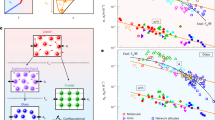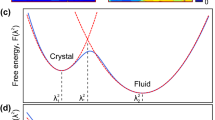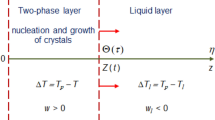Abstract
THE elastic instability theory of melting, proposed by Max Born1, held that melting in a crystalline material occurs when one of the elastic shear moduli vanishes, so that the material can no longer sustain an infinitesimal shear stress without flowing. This explains the fluidity of a melt, but fails to account for several other important characteristics of melting. Melting is a transition between two independent phases, while Born's theory is a single-phase theory which contains no distinct description of the melt, and thus fails to account for the discontinuous, first order character of melting. Because it is an essentially homogeneous theory, it does not explain the occurrence of superheating, the metastability of the melt, and the heterogeneous nucleation and growth features of the melting process. Also, subsequent observations of elastic moduli showed that none of the shear moduli is zero or near zero in the solid at the melting point. Because of these defects Born's instability theory currently enjoys little credibility. We believe, however, that correct application of Born's hypothesis leads to a simple modification of his initial criterion for melting which satisfies all the requirements of a physically realistic theory of melting. We show here that the hypothesis does predict a first-order transition between two phases and that the transition has a nucleation barrier, thus dismissing some of the physical objections to the hypothesis. Moreover, the hypothesis applies in the alkali halides, in that in each case one of the shear moduli falls continuously to zero through the melting expansion.
This is a preview of subscription content, access via your institution
Access options
Subscribe to this journal
Receive 51 print issues and online access
$199.00 per year
only $3.90 per issue
Buy this article
- Purchase on Springer Link
- Instant access to full article PDF
Prices may be subject to local taxes which are calculated during checkout
Similar content being viewed by others
References
Born, M. J. chem. Phys. 7, 591 (1939).
Srivastava, K. K. & Merchant, H. D. J. phys. Chem. Solids 34, 2069 (1973).
Schinke, H. & Sauerwald, F. Z. anorg. Chem. 287, 313 (1965).
Hearmon, R. F. S. in Landolt-Bornstein, New Series III, 1, 1 (Springer, Berlin, 1966).
Antonov, P., Kardashev, B. & Nikanorov, S. Soviet Phys. solid St. 9, 527 (1967).
Tallon, J. L. thesis Victoria Univer. Wellington (1976).
Tallon, J. L., Robinson, W. H. & Smedley, S. I. (submitted to Phil. Mag.).
Author information
Authors and Affiliations
Rights and permissions
About this article
Cite this article
TALLON, J., ROBINSON, W. & SMEDLEY, S. A melting criterion based on the dilatation dependence of shear moduli. Nature 266, 337–338 (1977). https://doi.org/10.1038/266337a0
Received:
Accepted:
Issue Date:
DOI: https://doi.org/10.1038/266337a0
This article is cited by
-
A hierarchy of catastrophes as a succession of stability limits for the crystalline state
Nature (1989)
-
Crystal instability and melting
Nature (1982)
-
Cooperativity in the dislocation theory of melting
Nature (1978)
Comments
By submitting a comment you agree to abide by our Terms and Community Guidelines. If you find something abusive or that does not comply with our terms or guidelines please flag it as inappropriate.



